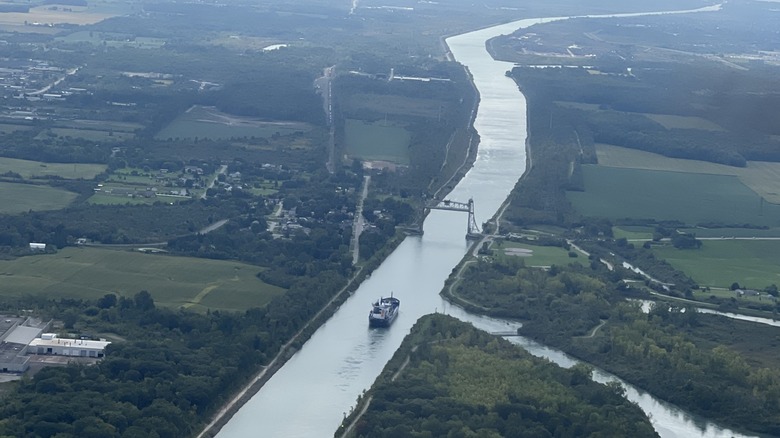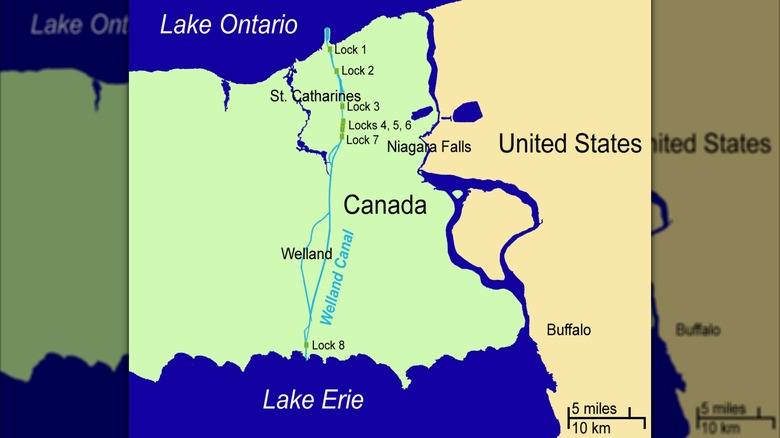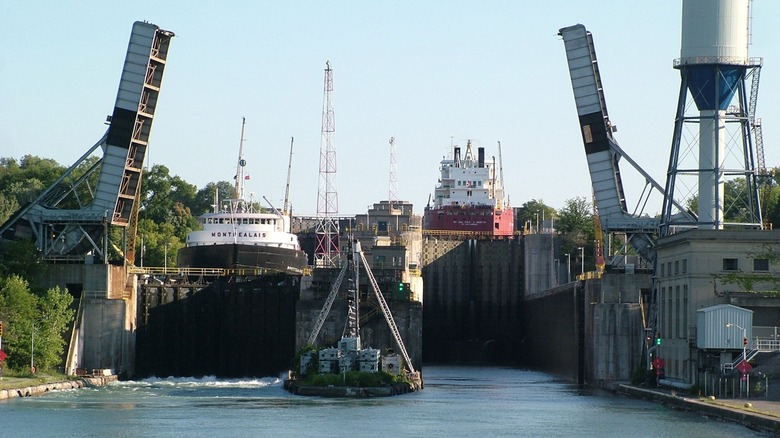Why The Welland Canal Is Important For Ships That Need To Bypass Niagara Falls
Niagara Falls is a go-to spot for tourists and honeymooners and was even home to the first hydropower station, built shortly after the first modern power lines were invented. However, it's largely a no-go for merchant ships, despite its strategically significant location on the border of Canada and the United States. Niagara Falls, which is 177 feet high at its tallest point, is part of the Niagara River — the only natural waterway that connects Lake Ontario and Lake Erie. Both are vitally important to trade and transportation.
Because it's pretty much impossible for ships to navigate the part of the Niagara River that literally falls off a cliff (actually, there are multiple falls and rapids in this region), a man-made waterway needed to be built to connect the two Great Lakes, bypassing the Niagara (both Falls and River) completely. This was first proposed way back in the early 1700s by French settlers, with the Welland Canal eventually built and opened in the 1820s. As ships became larger and trade became more common, the Welland Canal was rebuilt and expanded multiple times.
The modern canal is its fourth iteration and began construction in 1913 before opening in 1932 (World War I slowed development). It connects Port Weller on Lake Ontario with Lake Erie's Port Colborne, running roughly perpendicular to the Niagara River between 4-6 miles west of it. As opposed to many other canals in the region, the Welland Canal is specifically designed and built for large deep draft commercial ships. Considering just how many containers can fit on a single container ship, the Welland Canal — by circumventing the Niagara Falls — plays a crucial role for North American trade.
How long is the Welland Canal and how many locks does it have?
Running a fairly straight north-to-south path, the Welland Canal is more than half a mile wide at its widest and 27.6 miles long, which equates to 24 nautical miles or 44.4 kilometers. That's about ¾ the length of the entire Niagara River, which the canal basically replaces as a route from Lake Ontario to Lake Erie. The Welland Canal consists of eight separate locks, which act as waterway elevators that can lift or lower ships to allow them to safely navigate the canal. The Welland Canal's locks can raise or lower ships around 330 feet.
Because it's particularly built for larger commercial ships, the Welland Canal has a controlling depth of about 27 feet and a maximum permissible draft of 26 feet. Vessels entering and using the Welland Canal cannot be longer than 740 feet or wider than 78 feet (standard Seawaymax dimensions used in the Great Lakes–St. Lawrence Seaway System). That covers most regional cargo vessels, but the canal would be too small for many larger international container ships — the Panama Canal, by comparison, can fit ships 966 feet long and 106 feet wide, though it's still not large enough to fit modern aircraft carriers.
Another restriction for ships traveling the Welland Canal is air draft, as vertical clearance is limited to 116.5 feet due to bridges that cross the waterway. Additionally, ships are not allowed to tow anything behind them while on the canal. The speed limit in the Welland Canal is 6 knots (though it's 8 knots from Port Robinson to Ramey's Bend). On average, it takes around 10 hours for a vessel to transit from one end to the other (though it can take over 12 hours).
There's at least one big difference between the Welland Canal and the Erie Canal
The Erie Canal might be the better known man-made waterway in the region, but, while it does connect the Great Lakes to the Atlantic Ocean (indirectly), the Welland Canal is currently much more important when it comes to commercial shipping. Despite being an incredibly important trade route during the height of the industrial revolution, these days, the Erie Canal (which runs from Lake Erie to the Hudson River) is primarily used for tourist and recreational activities, such as exploring scenic upstate New York and paddle boating.
On the Welland Canal, commercial ships are given priority over pleasure craft when it comes to transiting its locks. Another reason the Welland Canal is far less ideal for recreational ships than the Erie is that it has rougher waters. In fact, any vessel crossing the Welland Canal must have at least two (northbound) or three (southbound) crew members aboard to make sure it can safely navigate choppy currents (going south requires going up in elevation, hence the extra crew requirement).
In addition to rougher waters, weather is an important factor when navigating the Welland Canal. Whereas the Erie Canal is located entirely within the state of New York, the Welland Canal sits completely within Canada's borders and can face very harsh winters. The Welland Canal closes for the season, typically from early winter to early spring. The window in which the waterway is too dangerous to use may evolve over time, however, as climate change causes seasonal weather to become more tumultuous and unpredictable. Unfortunately, when the canal is closed due to weather, ships are out of luck, because sailing off Niagara Falls is not an option.


